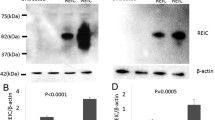Abstract
This study is designed to examine the radiosensitizing effects of coexpression of doublecortin (DCX) and secreted protein and rich in cysteine (SPARC). Previously, we showed that downregulation of SPARC by small interfering RNA increased radioresistance of U-87MG glioma cells. Therefore, overexpression of SPARC might increase radiosensitivity of glioma cells. But SPARC has been shown to promote glioma cell invasion both in vitro and vivo. In order to radiosensitize glioma cells without stimulating invasion, we chose DCX, which is a well-characterized anti-tumor gene, to coexpress with SPARC. An adenovirus-mediated double gene expression system was constructed and applied to U251 and A172 glioma cell lines. Our data showed that coexpression of DCX and SPARC collaboratively diminished radioresistance of glioma cells, interfered with cell cycle turnover and increased irradiation-induced apoptosis. In addition, transwell assay revealed that coexpression was able to counteract the invasion-promoting effects of SPARC, and even inhibited intrinsic invasion, evidenced by less invading cells in double gene overexpressed group than that of control adenovirus-treated group. In conclusion, genetic engineering combining two or more genes might be a more effective method to overcome radioresistance of glioma cells.




Similar content being viewed by others
References
Alam R, Schultz CR, Golembieski WA, Poisson LM, Rempel SA (2013) PTEN suppresses SPARC-induced pMAPKAPK2 and inhibits SPARC-induced Ser78 HSP27 phosphorylation in glioma. Neuro Oncol 15(4):451–461
Brekken RA, Sage EH (2001) SPARC, a matricellular protein: at the crossroads of cell-matrix communication. Matrix Biol 19(8):816–827
Gleeson JG, Walsh CA (2000) Neuronal migration disorders: from genetic diseases to developmental mechanisms. Trends Neurosci 23(8):352–359
Golembieski WA, Rempel SA (2002) cDNA array analysis of SPARC-modulated changes in glioma gene expression. J Neurooncol 60(3):213–226
Jiang X, Xu Y, Zhang H, Yu J, Yang J, Liu F (2013) Effects of DCX and SPARC co-expression on the apoptosis of human glioma cells U-87MG induced by X-rays irradiation. J Radiat Res Radiat Process 31(1):10–15 (in Chinese)
Liu H, Zhang H, Jiang X, Ma Y, Xu Y, Feng S, Liu F (2011) Knockdown of secreted protein acidic and rich in cysteine (SPARC) expression diminishes radiosensitivity of glioma cells. Cancer Biother Radiopharm 26(6):705–715
Lord CJ, Ashworth A (2012) The DNA damage response and cancer therapy. Nature 481(7381):287–294
McClung HM, Thomas SL, Osenkowski P, Toth M, Menon P, Raz A, Fridman R, Rempel SA (2007) SPARC upregulates MT1-MMP expression, MMP-2 activation, and the secretion and cleavage of galectin-3 in U87MG glioma cells. Neurosci Lett 419(2):172–177
McClung HM, Golembieski WA, Schultz CR, Jankowski M, Schultz LR, Rempel SA (2012) Deletion of the SPARC acidic domain or EGF-like module reduces SPARC-induced migration and signaling through p38 MAPK/HSP27 in glioma. Carcinogenesis 33(2):275–284
Pawlik TM, Keyomarsi K (2004) Role of cell cycle in mediating sensitivity to radiotherapy. Int J Radiat Oncol Biol Phys 59(4):928–942
Rich JN, Hans C, Jones B, Iversen ES, McLendon RE, Rasheed BK, Dobra A, Dressman HK, Bigner DD, Nevins JR, West M (2005) Gene expression profiling and genetic markers in glioblastoma survival. Cancer Res 65(10):4051–4058
Santra M, Zhang X, Santra S, Jiang F, Chopp M (2006) Ectopic doublecortin gene expression suppresses the malignant phenotype in glioblastoma cells. Cancer Res 66(24):11726–11735
Santra M, Santra S, Roberts C, Zhang RL, Chopp M (2009) Doublecortin induces mitotic microtubule catastrophe and inhibits glioma cell invasion. J Neurochem 108(1):231–245
Santra M, Zheng X, Roberts C, Santra S, Lu M, Panda S, Jiang F, Chopp M (2010) Single doublecortin gene therapy significantly reduces glioma tumor volume. J Neurosci Res 88(2):304–314
Schultz C, Lemke N, Ge S, Golembieski WA, Rempel SA (2002) Secreted protein acidic and rich in cysteine promotes glioma invasion and delays tumor growth in vivo. Cancer Res 62(21):6270–6277
Van Meir EG, Hadjipanayis CG, Norden AD, Shu HK, Wen PY, Olson JJ (2010) Exciting new advances in neuro-oncology: the avenue to a cure for malignant glioma. CA Cancer J Clin 60(3):166–193
Xie Y, Lv H, Sheng W, Miao J, Xiang J, Yang J (2011) Synergistic tumor suppression by adenovirus-mediated inhibitor of growth 4 and interleukin-24 gene cotransfer in hepatocarcinoma cells. Cancer Biother Radiopharm 26(6):681–695
Acknowledgments
This study was supported by the National Natural Science Foundation of China (No. 31270897, 81271682, 30870585) and Graduate Innovation Foundation of Medical College of Soochow University and A Project Funded by the Priority Academic Program Development of Jiangsu Higher Education Institutions (PAPD).
Conflict of interest
The authors declare that they have no conflict of interest.
Author information
Authors and Affiliations
Corresponding author
Additional information
Yuanyuan Xu and Lei Yang have contributed equally to this study.
Rights and permissions
About this article
Cite this article
Xu, Y., Yang, L., Jiang, X. et al. Adenovirus-Mediated Coexpression of DCX and SPARC Radiosensitizes Human Malignant Glioma Cells. Cell Mol Neurobiol 33, 965–971 (2013). https://doi.org/10.1007/s10571-013-9963-2
Received:
Accepted:
Published:
Issue Date:
DOI: https://doi.org/10.1007/s10571-013-9963-2




